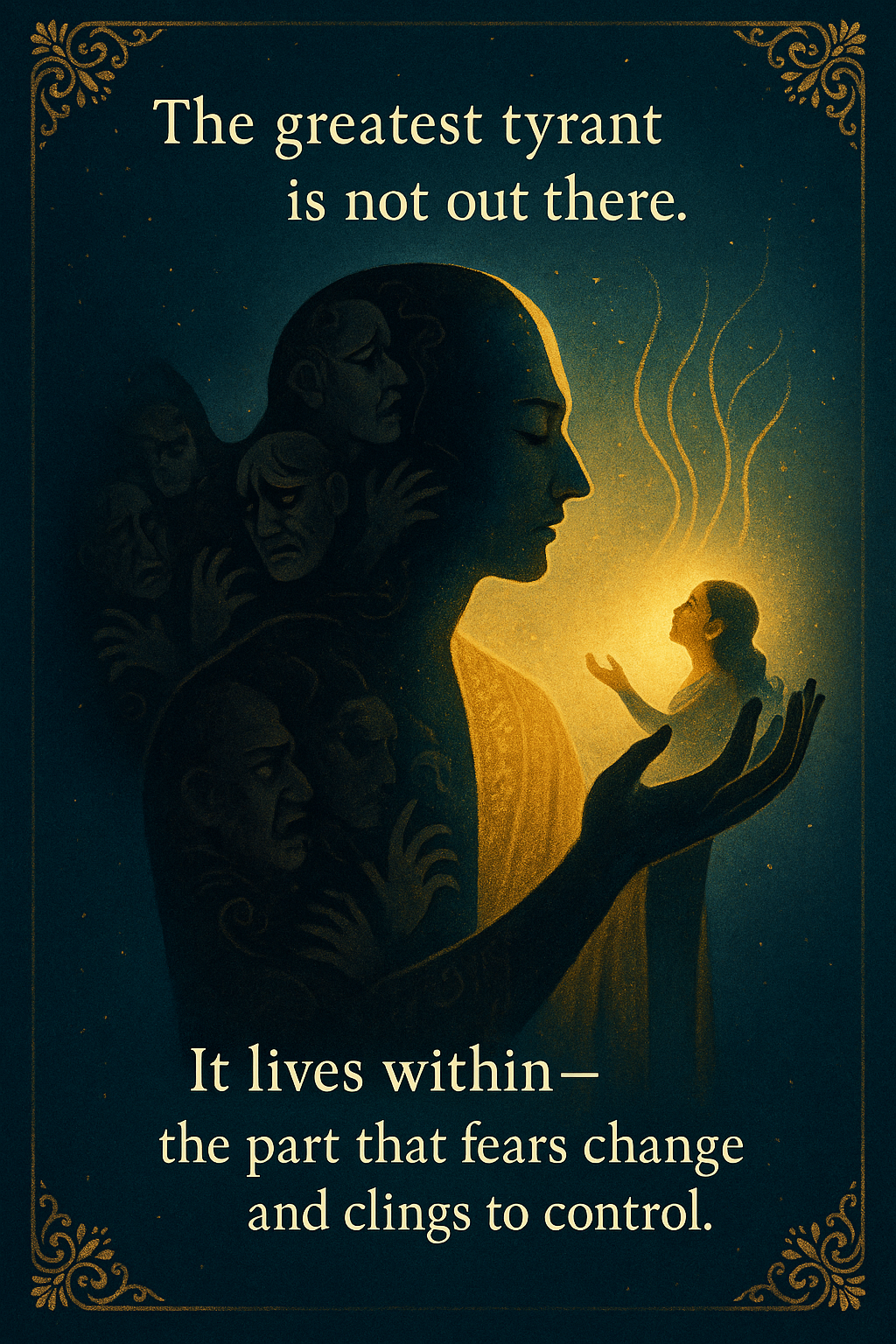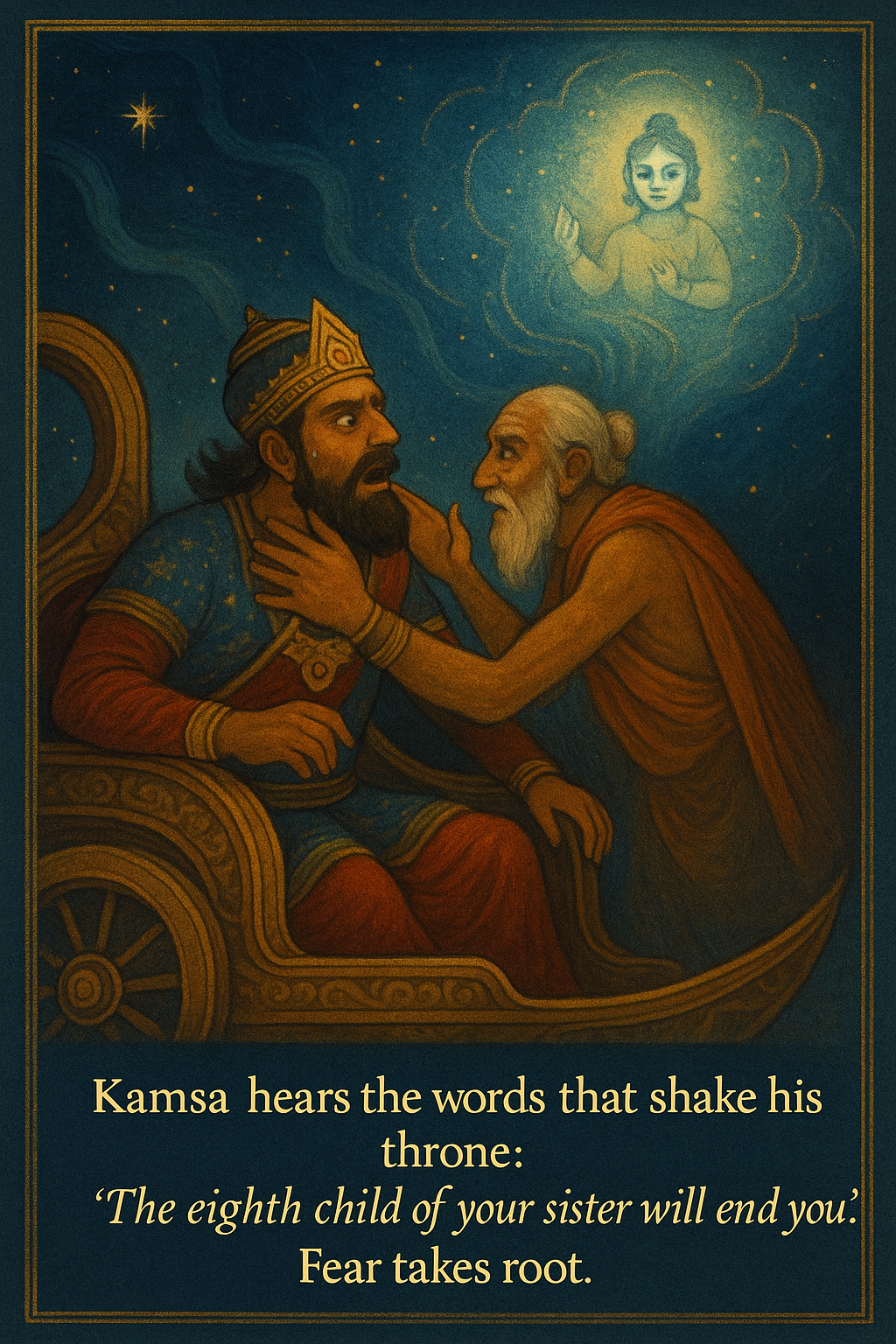Krishna Leelas: When Darkness Reigns, Consciousness Awakens
This is not merely a tale from the past.
It is a map of the human condition, an allegory of how fear, ego, and attachment can distort perception, breed destruction, and how the quiet force of higher intelligence and divine alignment ultimately prevails.
The story of Kamsa is not just about a ruthless king. It is about the inner tyrant that lives within all of us, the part that reacts from insecurity, clings to control, and wages war against the unknown when faced with the discomfort of change.
The Birth of Fear
Kamsa, a powerful ruler, once heard a prophecy that the eighth child of his sister would be the cause of his downfall.
Fear took root so deeply that it eclipsed his reason.
Instead of reflecting, he chose to dominate.
He imprisoned his sister Devaki and her husband Vasudeva, and one by one, killed their newborns.
This was not strength but terror masquerading as power, a terror of change, of losing control, of transformation itself.
The Eighth Child
When the long-feared eighth child was born, Kamsa rushed to destroy it. Yet the infant slipped from his grasp and revealed itself as Yoga Maya, the cosmic intelligence that governs the unfolding of life.
She told him:
“The one you fear is born elsewhere. Your plan is futile.”
In that moment, something in him cracked open.
He saw the futility of his violence and sought forgiveness, touched by the purity of Devaki and Vasudeva’s presence.
But this awakening was fragile.
The voices that surrounded him… his ministers, who mirrored his darkness, whispered fear back into his heart.
He descended again, this time with even greater cruelty, ordering the killing of all infants in his kingdom and striking out against symbols of wisdom, compassion, and higher truth.
The Mirror Within
It is here that the story begins to mirror our inner struggles.
Fear, left unchecked, breeds the urge to control and destroy.
And the collapse begins long before the act.
It begins in the mind.
A single thought of fear can spiral into suspicion and then into harm.
This is what the ancient texts call Asuri Buddhi, the demonic intelligence that convinces us that breaking moral boundaries is necessary for self-preservation.
The tragedy is that without deep self-inquiry, even repentance is temporary.
Kamsa’s moment of clarity dissolved because he never examined his fear, never transformed its root.
The Company We Keep
The company he kept sealed his fate.
Just as a clear spring turns muddy when fed by a dirty stream, his mind, once briefly lit by remorse, was darkened by those who fed his illusions.
This is how even the repentant can relapse into harm.
Wisdom grows in the company of the clear-hearted, but it withers in the company of those who thrive on manipulation and fear.
Leadership and decision-making are no different.
They rise or decay based on the moral quality of the voices we allow near us.
Yoga Maya - The Quiet Force
Yet the presence of Yoga Maya in this story reminds us that there is always a greater intelligence at work, quietly ensuring that what must evolve will evolve, and what must fall will fall.
She is the unseen protector of the evolutionary path, the force that bends events toward balance and truth, no matter how oppressive the present may seem.
And she is not confined to myth.
In our own lives, Yoga Maya appears in many forms:
A near disaster turning into a breakthrough
An inner voice that pulls us back from the edge
A sudden realisation that stops us from repeating an old mistake
A moment of grace that shields someone vulnerable — through what seems like chance, but is not
She is not magic; she is alignment, guiding us toward growth often before we are ready to see it.
The Invitation
When we look closely, the story speaks as much to our journeys as it does to our shared human story.
In our own lives, comfort is often shattered not to punish us but to invite us into expansion.
The part of us that fears losing control, our inner Kamsa, will disguise itself as logic or urgency, urging us to clamp down and silence what we do not understand.
But the invitation is to notice it, not obey it.
It asks us to examine the voices we let shape our minds:
Are they rooted in clarity or fear?
In wisdom or reaction?
In the collective sphere, it urges us to challenge systems built on suppression, to stand with truth even when it is quiet, and to protect the tender forces that nourish our shared consciousness, ethical wisdom, environmental balance, compassion in dialogue, for these are the children of our modern world that must be defended.
The Choice
In the end, the fall of Kamsa was not destiny written in the stars.
It was the result of his refusal to evolve.
Kamsa is the part of us that resists transformation.
Yoga Maya is the part of existence that ensures transformation happens anyway.
When fear clouds our inner vision, we fall.
When we surrender to a greater intelligence, through humility, awareness, and right action, we rise.
And so the story is not locked in the past.
It is unfolding in each of us, right now, waiting for the moment when awareness will rise above fear.











